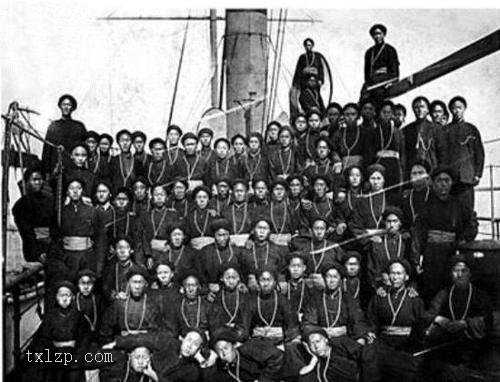Period:Han dynasty Production date:2ndC BC-2ndC AD
Materials:jade
Technique:incised, polished,
Subjects:chimaera
Dimensions:Height: 3.80 centimetres Width: 5.90 centimetres
Description:
Jade carving in the form of a crouching chimera.
IMG
![图片[1]-figure BM-2022-3034.254-China Archive](https://chinaarchive.net/Han dynasty/Jades/683_1.jpg)
![图片[2]-figure BM-2022-3034.254-China Archive](https://chinaarchive.net/Han dynasty/Jades/683_2.jpg)
![图片[3]-figure BM-2022-3034.254-China Archive](https://chinaarchive.net/Han dynasty/Jades/683_.jpg)
![图片[4]-figure BM-2022-3034.254-China Archive](https://chinaarchive.net/Han dynasty/Jades/683_4.jpg)
Comments:The powerful beast with front legs wide apart and pointing slightly inwards, the back legs splayed, the long bushy tail divided in two and with the longer section further divided into two spirals, the head raised with jaws agape; the stone of pale greyish-green colour with large areas and fissures of rich reddish brown and with areas of opaque greyish-brown. Six Dynasties period (220-580). Possibly Western Han period. This exceptionally powerful beast is suggested by a forceful, compact, almost square body, tensed on four short legs. The very shortness of the body seems to indicate compressed strength. The highly polished translucent stone makes the creature even more awe-inspiring. An angular head, with squared horns and snout, is tilted slightly upwards. In the open jaw are fine teeth. The brows are embellished with striations, and between them is a small hatched triangle. An incised branching line extends down the back of the head. Slightly squared eyes are modelled in relief, with somewhat unusual small incised circular pupils. Such pupils are, however, found on a number of very high-quality jades of the early Han period, including some of the exceptional and unusual jades form the tomb of the King of Nan Yue at Canton. Among these pieces are a large animal head with a ring in its jaw, a belt hook in the form of a dragon grasping a small ring and an animal facet terminal on a magnificent belt hook consisting of beads and plaques along an iron armature. The most distinctive feature of this beast is the deeps swirl on the underside representing a bifurcated tail. The deep twisted grooves of this tail are vey like those on the twisted tails of jade file dragons of the late Eastern Zhou or Han dynasty; they appear especially on dragons shown in silhouette rising above discs and sword fittings. As with the pupils in the eyes, these twisted tails were especially popular in the third and second centuries BC at the time of the burial of the King of Nan Yue. Again his tomb offers many examples on sword fittings. Further, the same twisted tail is treated as an abstract ornament on a ring, where it is worked into an interlace pattern. Such decorative treatment suggests that tail patterns were especially popular at this date. A band of lines and scrolls indicates the fur along the back of the creature; on the chest are overlapping feather-like elements. Interlocking Cs incised on the body, especially on the rear, are typical of the early Han period, and appear on many pendants and other fittings of this time, including a number from the tomb of the King of Nan Yue. These designs are much less common on the surviving three-dimensional animals, such as the creatures from the tomb of Yuandi and no.682 [2014,AsiaLoan,1.44]. It is possible that this beast predates the animals from the Yuandi tomb and no.682 [2014,AsiaLoan,1.44]. If so it belongs to a period for which we have only comparative evidence from other types of jade carving, such as those cited on pg.364. The comparisons are, however, very instructive and the animal in itself is of a type that might have been expected to appeal to the peoples of the day. It is a powerful mythical beast, in the tradition of the man riding an imaginary creature from Luoyang. In Sotheby’s sale 1979, it was dated Ming dynasty and some people in HK think it Six Dynasties to Tang period. See Rawson 1995, pp.361-363, cat.no.26.6, and Bluett 1981.
Materials:jade
Technique:incised, polished,
Subjects:chimaera
Dimensions:Height: 3.80 centimetres Width: 5.90 centimetres
Description:
Jade carving in the form of a crouching chimera.
IMG
![图片[1]-figure BM-2022-3034.254-China Archive](https://chinaarchive.net/Han dynasty/Jades/683_1.jpg)
![图片[2]-figure BM-2022-3034.254-China Archive](https://chinaarchive.net/Han dynasty/Jades/683_2.jpg)
![图片[3]-figure BM-2022-3034.254-China Archive](https://chinaarchive.net/Han dynasty/Jades/683_.jpg)
![图片[4]-figure BM-2022-3034.254-China Archive](https://chinaarchive.net/Han dynasty/Jades/683_4.jpg)
Comments:The powerful beast with front legs wide apart and pointing slightly inwards, the back legs splayed, the long bushy tail divided in two and with the longer section further divided into two spirals, the head raised with jaws agape; the stone of pale greyish-green colour with large areas and fissures of rich reddish brown and with areas of opaque greyish-brown. Six Dynasties period (220-580). Possibly Western Han period. This exceptionally powerful beast is suggested by a forceful, compact, almost square body, tensed on four short legs. The very shortness of the body seems to indicate compressed strength. The highly polished translucent stone makes the creature even more awe-inspiring. An angular head, with squared horns and snout, is tilted slightly upwards. In the open jaw are fine teeth. The brows are embellished with striations, and between them is a small hatched triangle. An incised branching line extends down the back of the head. Slightly squared eyes are modelled in relief, with somewhat unusual small incised circular pupils. Such pupils are, however, found on a number of very high-quality jades of the early Han period, including some of the exceptional and unusual jades form the tomb of the King of Nan Yue at Canton. Among these pieces are a large animal head with a ring in its jaw, a belt hook in the form of a dragon grasping a small ring and an animal facet terminal on a magnificent belt hook consisting of beads and plaques along an iron armature. The most distinctive feature of this beast is the deeps swirl on the underside representing a bifurcated tail. The deep twisted grooves of this tail are vey like those on the twisted tails of jade file dragons of the late Eastern Zhou or Han dynasty; they appear especially on dragons shown in silhouette rising above discs and sword fittings. As with the pupils in the eyes, these twisted tails were especially popular in the third and second centuries BC at the time of the burial of the King of Nan Yue. Again his tomb offers many examples on sword fittings. Further, the same twisted tail is treated as an abstract ornament on a ring, where it is worked into an interlace pattern. Such decorative treatment suggests that tail patterns were especially popular at this date. A band of lines and scrolls indicates the fur along the back of the creature; on the chest are overlapping feather-like elements. Interlocking Cs incised on the body, especially on the rear, are typical of the early Han period, and appear on many pendants and other fittings of this time, including a number from the tomb of the King of Nan Yue. These designs are much less common on the surviving three-dimensional animals, such as the creatures from the tomb of Yuandi and no.682 [2014,AsiaLoan,1.44]. It is possible that this beast predates the animals from the Yuandi tomb and no.682 [2014,AsiaLoan,1.44]. If so it belongs to a period for which we have only comparative evidence from other types of jade carving, such as those cited on pg.364. The comparisons are, however, very instructive and the animal in itself is of a type that might have been expected to appeal to the peoples of the day. It is a powerful mythical beast, in the tradition of the man riding an imaginary creature from Luoyang. In Sotheby’s sale 1979, it was dated Ming dynasty and some people in HK think it Six Dynasties to Tang period. See Rawson 1995, pp.361-363, cat.no.26.6, and Bluett 1981.
© Copyright
The copyright of the article belongs to the author, please keep the original link for reprinting.
THE END



![[Qing Dynasty] British female painter—Elizabeth Keith, using woodblock prints to record China from the late Qing Dynasty to the early Republic of China—1915-China Archive](https://chinaarchive.net/wp-content/uploads/2022/11/image-191x300.png)

